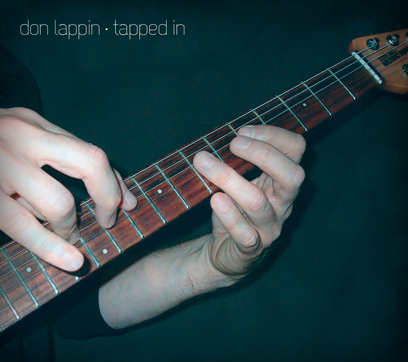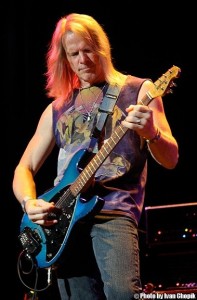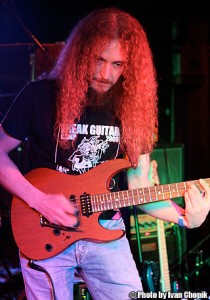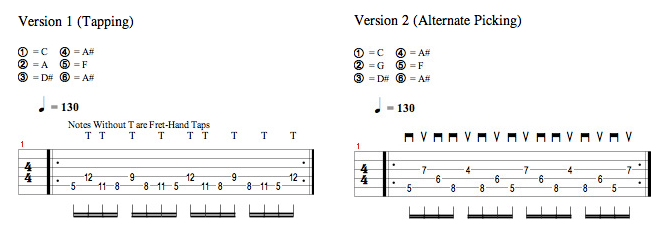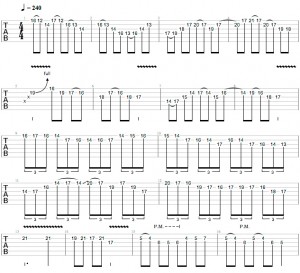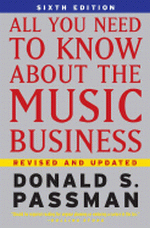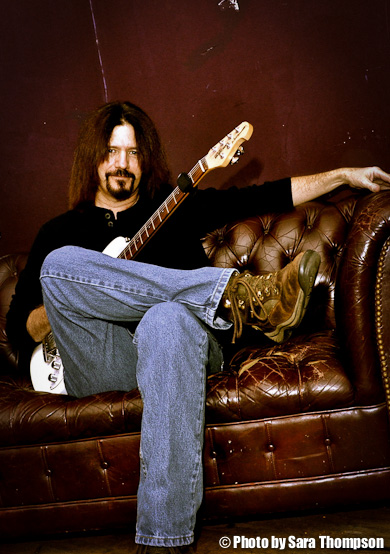 Don Lappin is renowned for his one-of-a-kind voice on his instrument, developed in part due to his unorthodox two-handed tapping technique. Paired with a keen sense of melody, the approach allows him to craft fretboard-spanning lines with a distinct fluidity that reminds the listener of a violin-like tone, rather than a traditional rock guitar growl. His instrumental rock album, Tapped In, is a milestone release for the guitar world and provides essential listening for fans of Joe Satriani, Eric Johnson, Guthrie Govan, and Steve Morse.
Don Lappin is renowned for his one-of-a-kind voice on his instrument, developed in part due to his unorthodox two-handed tapping technique. Paired with a keen sense of melody, the approach allows him to craft fretboard-spanning lines with a distinct fluidity that reminds the listener of a violin-like tone, rather than a traditional rock guitar growl. His instrumental rock album, Tapped In, is a milestone release for the guitar world and provides essential listening for fans of Joe Satriani, Eric Johnson, Guthrie Govan, and Steve Morse.
Don has been playing professionally since the age of eleven and went on to attend Berklee College of Music, where he graduated “summa cum laude” with a Bachelor’s degree in performance. He later reconnected with Berklee to become an in-demand professor in the guitar department since 1997. He fronts his own instrumental rock band, The Don Lappin Group, and is an active clinician with a busy performance schedule throughout the year. I had the pleasure of conducting this interview with Don on November 26th, 2013:
IC: What is currently happening in the world of Don Lappin?
DL: Right now I am mostly concentrating on teaching, both at Berklee and with my own private practice, and promoting Tapped In in any way I can. I am also working on new videos for my YouTube channel, as well as preparing to begin writing new material.
IC: Earlier this year you released your most recent work, Tapped In. When did you first begin writing material for the album and how did the tunes come together?
DL: Tapped In is a mix of some older material like Captain’s Lady, Drivin,’ and West Tide. I wrote those a few years back, but never recorded them. The newer stuff was written specifically for this album. Lappin It Up, Past & Present, A Song For Robert, and Weathering The Storm are my most recent songs.
IC: What was recording process like for Tapped In? How did you end up collaborating with Steve Hunt [Keys], Joe Santerre [Bass], and Chad Wackerman [Drums] during these sessions?
DL: I’ve known and played with both Joe and Steve for many years. They are both Berklee Professors, as well. I met Chad through Steve, because they played together for many years with Allan Holdsworth. I went to a Holdsworth show here in Boston a few years ago with Steve. That’s where I met Chad and that is how he ended up playing drums on my album.
We recorded this project in four different studios. Chad did his drums at his studio in California, Joe’s Bass and all of Steve’s Keys were done in Steve’s studio (The Kitchen) in Chelmsford, MA, and I recorded all my guitars here in my studio. The album was mixed by Sabi Saltiel in L.A., and was mastered by Steve.
IC: What first inspired you to explore two-hand tapping techniques? At which point did you transition away from traditional playing approaches in favor of your own tapping-centric system?
DL: I began messing around with a tapping technique way back, when I was about 16 or 17. I spent a few years trying to develop my picking and sweeping, but it never felt natural to me. I was doing the tapping thing more and more and soon started developing a bit of a reputation for it, especially later when I was a Berklee student. It was about at that point where I decided to go all out and develop a system for it. 30 years later, I’m still at it, haha….
IC: While many guitarists organize their scale patterns using the three-note-per-string approach, you actually take it one step further, playing four notes per string – two notes in your left hand and two in your right hand. What motivated you to reorganize the fretboard this way?
DL: I was messing around one day with three-notes-per-string and realized that as I moved from a lower string to a higher string (Low E-string to A-string, for example), I was ascending up a diatonic 4th (cycle 4). Out of curiosity, I began taking a look at what would happen if I used four notes instead of three. I realized that as I moved from a low string to higher string using four notes, I would be ascending a diatonic 5th (cycle 5).
As I continued exploring this idea, I realized that using four-notes-per-string was an amazingly simple and symmetrical way of connecting the major scale modes. I came up with an approach called ‘The Fraction System,’ which I have been teaching my Berklee students for many years now. I discuss this topic in detail on my instructional DVD, which is available through my website, www.DonLappinMusic.com. In recent years, I have come back to three-notes-per-string in a whole new way. I now use both approaches about equally.
IC: Do you ever find yourself grabbing a pick and playing traditional style these days?
DL: No, haha… 100% of my phrasing is done with two hands. Playing in a traditional way feels very foreign to me. At least 70% of my notes are actually played with my right hand, not my left.
IC: Let’s talk about gear. What inspired you to choose the Ernie Ball Music Man Silhouette guitar as your main axe? Which DiMarzio pickups do you find to be the most suitable for your playing style?
DL: I began using the Silhouette in 2005. I spent a year with Parker and realized their guitars really weren’t for me. During that year, students would come in with MM guitars, mostly the John Petrucci models, and I would try them out and be blown away every single time! I was already using Ernie Ball strings, so I had a conversation with Derek Brooks at Ernie Ball and made the switch to Music Man. I have been playing them ever since – I love them! Due to my playing style, I’ve always preferred high output pickups. Right now, my main guitar has a Tone Zone in the Bridge and an Air Norton in the neck.
IC: What’s your general approach to setting up the EQ and overdrive settings on your ENGL Invader amp? How does the Palmer Speaker Simulator factor into your tone?
DL: I use Channel 2 as my main lead channel. I use the high gain setting and the EQ is pretty much in the middle, although the treble is turned down to two or three most of the time. In any amp, I start with all the EQ settings in the middle and adjust in very small increments from there, until I have my desired sound. This varies depending on the room/venue, etc….
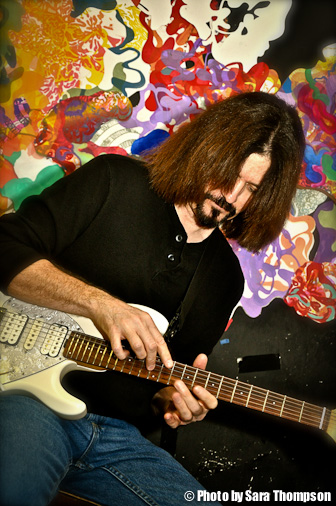
I use the Palmer mostly for my YouTube videos and when I’m writing. When I am doing serious recording, I prefer to use mics. I do love the Palmer though and will never get rid of it!
IC: You first picked up the guitar at age seven and started playing professionally with your original rock group, ‘The Destroyers’ by the time you turned eleven. What were the gigs like then and at which point did you transition into becoming a solo artist? How has the landscape for instrumental rock music changed over the years?
DL: It’s hard to remember that far back, haha. I know there were TONS more places to play back then, that’s for sure. Nowadays, we have less and less venues to play at, especially in smaller cities like Boston. Unfortunately, it’s also much harder to sell our music now, too. Instrumental music has always enjoyed a much smaller audience, overall, than more mainstream music.
However, having said that, each of us has a potential audience. A big part of our job is to seek out that audience, so that they have access to our music. GM is one of those avenues and does a great job of spreading the word.
IC: You began your studies at Berklee College of Music in 1990. After graduating, how did you end up reconnecting with the college in 1997 to become a professor in the guitar department?
DL: Well, I was an older student when I attended Berklee. As a result, I was already doing a lot of gigging and teaching, while I was a student there. I was also teaching there during the Summer Programs (Guitar Summer Sessions). So, given my prior experience and my approach to playing, they asked me to join the faculty.
IC: Having taught at Berklee for over fifteen years, you’ve had the opportunity to connect with several generations of students. How has your teaching strategy evolved over the years? What kind of changes and emerging trends do you see amongst your students with each new year?
DL: I believe that I’ve become much more comfortable teaching at Berklee over the years. My goal as an instructor has always been to help my students discover their own voice on the instrument. Each of us is unique and it’s important to find that uniqueness and utilize it. For me, it’s my tapping technique; not just the physical part, but the sound that it gives to my playing. My phrasing, my finger tone; I want to be able to play a few notes and have people recognize who I am. And that’s what I want my students to discover in themselves. It goes way beyond scales, fingerings, arpeggio patterns, etc…
One trend that I’ve seen over the last few years is influenced by what players like Guthrie Govan have been doing. He’s so great at taking from soooo many musical styles, whether it’s Jazz, Rock, Country, Blues, you name it… and weaving it all into something really unique and all his own. I am noticing this having a huge impact on my students. It’s a really cool thing and is very inspiring.
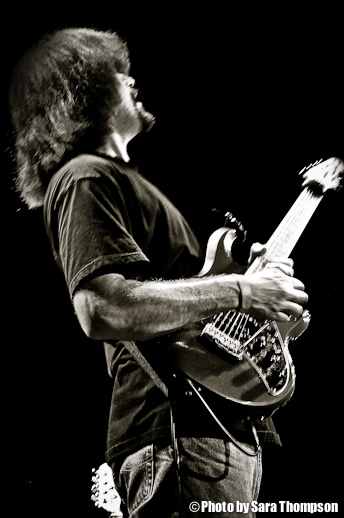
IC: What are some common pitfalls your students may come across when first beginning to study your two-hand tapping technique and what are the best ways to overcome them?
DL: Teaching your right hand to do what your left has been doing for many years is definitely one, haha…. Also, learning how to get the necessary tone and attack without the use of a pick is pretty tough for some players. Another common pitfall is learning to become comfortable improvising with my technique. This stuff takes a while. Most of my students take bits and pieces of what I do and augment what they are already doing. I believe that this is a great strategy.
IC: What are you listening to these days? Any recent discoveries that we should check out?
DL: Honestly, I don’t actually listen to a lot of guitar instrumental music. It’s mostly because I always have a guitar in my hand so when I don’t, I kind of need a break, haha….When I do though, it’s usually a Satriani or Jeff Beck record. I have also always loved Allan Holdsworth’s, Andy Timmons,’ and Tommy Emmanuel’s music, too. Lately, though, I’ve been listening to a lot of Porcupine Tree/Steven Wilson, old Rush and Yes albums, and a lot of film music.
IC: What can advice can you offer to aspiring players looking to take their playing to the next level?
DL: Figure out what you’re good at and develop that. Find some way of standing out from the crowd and search for what makes you unique and marketable. In addition to working hard and becoming a proficient musician, work on your personal and business skills. Show up on time to rehearsals and gigs, show up prepared, be dependable, stick to your word, and just be a cool person. All of these things are important to becoming a successful player.



